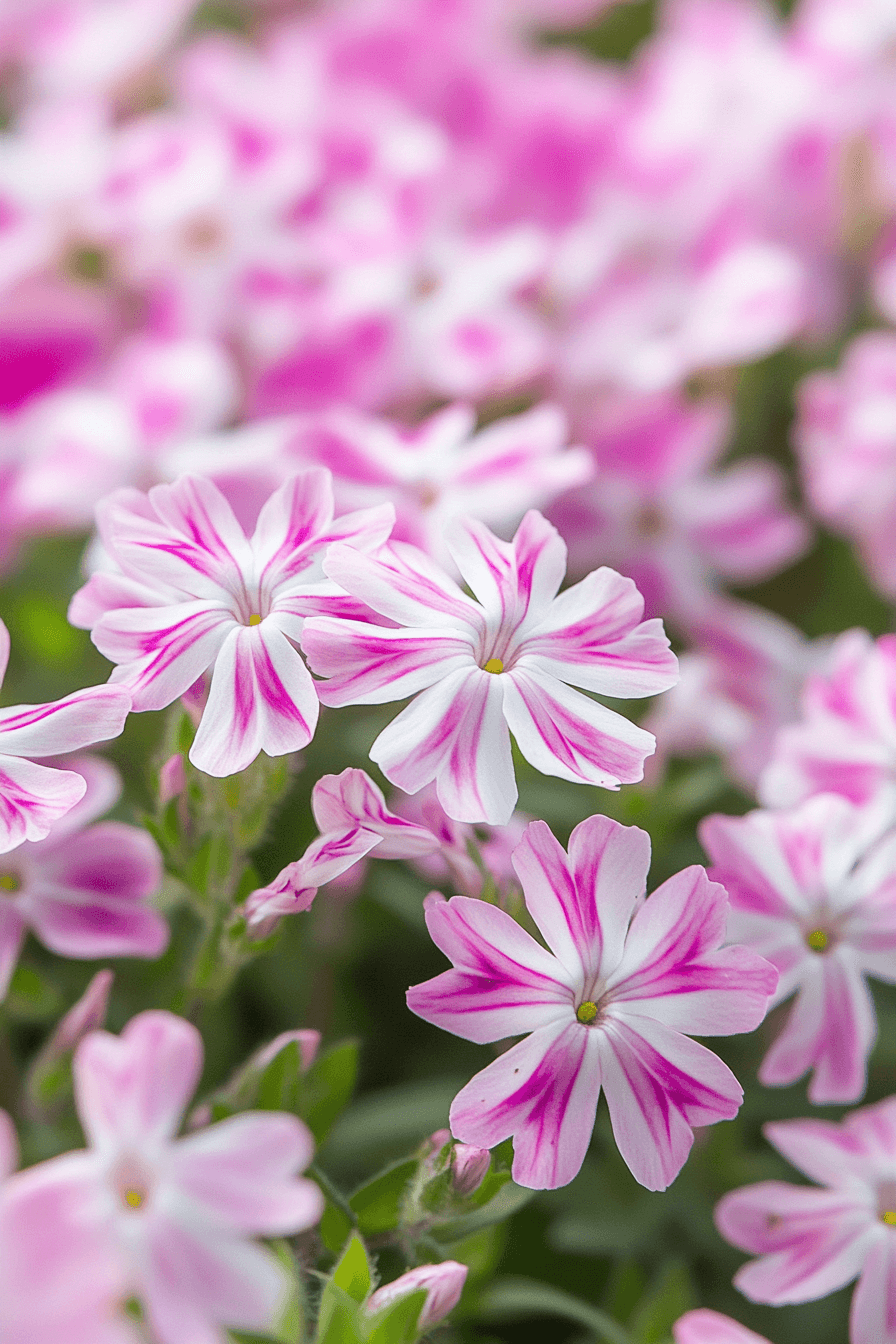There is a quiet poetry in the way flowers bloom—an ancient hymn whispered through petals and leaves. Phlox, with its clusters of delicate stars, has been my gentle companion through seasons of change, reflection, and growth. Its vibrant colors and tender presence feel like a mirror for the inner landscapes of resilience and feminine strength I nurture within myself.
Garden Phlox: Tall Stories of Bold Grace
Garden Phlox (Phlox paniculata) rises with confidence, a beacon of vibrant color and intoxicating fragrance. Varieties like ‘David’,

with its passionate crimson hues kissed by soft pink, evoke the fiery spirit of a woman standing her ground with fierce kindness. Meanwhile, ‘Bright Eyes’

, white petals adorned with a vivid violet center, reminds me of the clarity and sharp vision necessary to navigate life’s winding paths.
In tending to Garden Phlox, I find a meditation on persistence—the kind of steady blooming that happens not despite the heat or the storms, but because of them. Their scent fills the air, calling pollinators like butterflies and bees, symbols of community and nourishment that feed both garden and soul.
Care Tips: Plant Garden Phlox in full sun with well-drained, fertile soil. Water consistently during dry spells to maintain vibrant blooms. To prevent powdery mildew, ensure good air circulation by spacing plants properly and avoid overhead watering. Deadhead spent flowers regularly to encourage a longer flowering season.
Creeping Phlox: The Quiet Weavers of Color
Beneath the tall tales of Garden Phlox lies the humble yet profound story of Creeping Phlox (Phlox subulata). These low-growing groundcovers remind me that strength also lives in softness and persistence. Varieties like ‘Emerald Blue’

create a lush tapestry of blue-purple blooms, a soothing blanket of renewal at spring’s first light. The playful ‘Candy Stripe’,

with its whimsical pink-and-white petals, captures the dance of femininity—bold yet tender, simple yet striking.
The way Creeping Phlox weaves itself across rocky soil or worn garden paths is a quiet anthem to holding space gently, to healing through slow, deliberate growth. It teaches me that flourishing doesn’t always mean standing tall—sometimes it means bending low and spreading wide, reaching out to cradle the earth and those around us.
Care Tips: Creeping Phlox thrives in full sun to partial shade and well-drained, sandy or rocky soil. It requires minimal watering once established. Trim back after flowering to maintain a neat carpet and encourage denser growth. Its drought tolerance makes it ideal for rock gardens and slopes.
Phlox and Soft Feminism: A Blooming Metaphor
Phlox is more than a flower—it is a soft feminist’s muse. Each bloom, each cluster, is a testament to diversity and unity, a metaphor for the multifaceted nature of womanhood. These flowers teach me to embrace every shade of my identity—the fiery and the fragile, the visible and the unseen.
Caring for Phlox is a ritual of self-love and empowerment. As their colors shift through the seasons, I am reminded that growth is never linear. It is a cyclical dance of blooming, resting, and rising anew. Like these flowers, we too find strength in vulnerability and grace in persistence.
For those who wish to deepen their relationship with plants and their own inner worlds, I invite you to explore more of my reflections on slow living and emotional healing in the Garden Notes series . Let these stories be a balm for your soul and a guide for your own blooming.
FAQ: Your Gentle Guide to Phlox Varieties
Q1: What are the main differences between Garden Phlox and Creeping Phlox?
A1: Garden Phlox (Phlox paniculata) are tall, upright perennials that bloom in summer with fragrant, showy flower clusters, ideal for flower beds and cutting gardens. Creeping Phlox (Phlox subulata) are low-growing groundcovers that bloom in early spring, forming dense mats of vibrant color perfect for rock gardens and borders.
Q2: How do I care for Phlox to ensure healthy blooms?
A2: Phlox thrives in well-drained soil with ample sunlight (at least 6 hours daily). Regular watering and good air circulation help prevent powdery mildew, especially for Garden Phlox. Deadheading spent flowers encourages longer blooming periods.
Q3: Are Phlox flowers beneficial for pollinators?
A3: Yes, Phlox flowers are highly attractive to butterflies, bees, and hummingbirds, supporting garden biodiversity and ecosystem health.
Q4: Can Phlox varieties withstand different climates?
A4: Most Garden Phlox varieties prefer temperate climates with warm summers, while Creeping Phlox is hardy in cooler zones and often used as a groundcover in rockier, less fertile soils.
Q5: How can Phlox inspire personal growth and healing?
A5: Beyond their beauty, Phlox flowers symbolize resilience, diversity, and gentle strength—qualities that resonate with personal transformation and emotional healing, especially through embracing both vulnerability and empowerment.
May your garden—and your soul—be ever in bloom.
With warmth and tenderness,
Jojo Len
🌸 Keep Wandering Through the Garden
- A Gentle Guide to Lavender Varieties: Perfect Choices for Balcony, Aromatherapy & Garden Bliss
- Five Tender Sunflowers for Small Gardens & Big Feelings
- A Gentle Guide to 8 Classic Rose Varieties & Care Tips for Slow Living Gardeners
- A Gentle Guide to Cosmos: Three Varieties for Joyful, Wild Gardens
- Gentle Blossoms: A Zinnia Guide for Your Soulful Garden
- A Gentle Guide to Marigold Varieties
- A Gentle Guide to Petunia Varieties
- A Gentle Guide to Pansy Varieties: Faces of Resilience
- A Gentle Guide to Viola Varieties
- A Gentle Guide to Tulip Varieties
- A Gentle Guide to Lily Varieties
- A Gentle Guide to Chrysanthemum Varieties
- A Gentle Guide to Calendula Varieties
- A Gentle Guide to Nasturtium Varieties
- A Gentle Guide to Cornflower Varieties
👉 Explore more at jojolen.shop
- Pinterest: @GrowandGathertogether | Instagram: @jojolen6666
- Images © jojolen.shop — credit if shared. No commercial use without permission.
